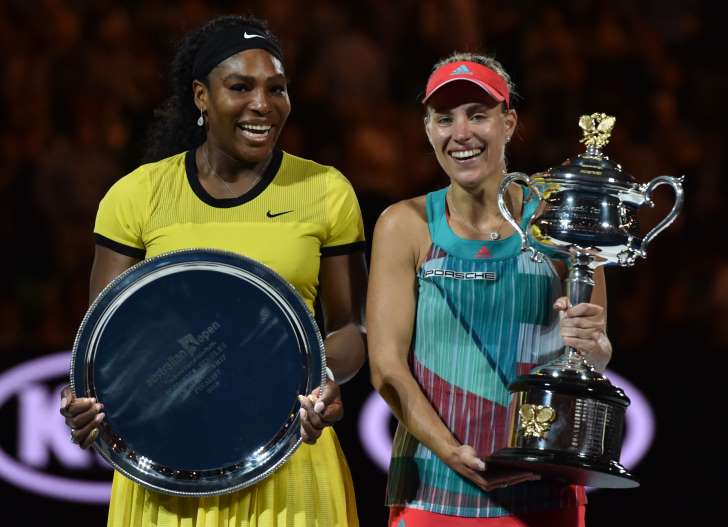March 27, 2013
By Geeta Goindi

At a reception for Astronauts Sunita Williams and Akihiko Hoshide, at the Embassy Residence, are seen from left to right: Indian Ambassador Mrs. Nirupama Rao; Williams; Hoshide; and Japan’s Ambassador to the US, Kenichiro Sasae. Photo credit: Embassy of India, Washington
March 27, 2013
By Geeta Goindi

At a reception for Astronauts Sunita Williams and Akihiko Hoshide, at the Embassy Residence, are seen from left to right: Indian Ambassador Mrs. Nirupama Rao; Williams; Hoshide; and Japan’s Ambassador to the US, Kenichiro Sasae. Photo credit: Embassy of India, Washington
WASHINGTON – Underscoring the importance of India-US space cooperation, a unique reception was held at the Embassy Residence, Friday evening. It was a heady combination of brilliance given the presence of Indian Ambassador Mrs. Nirupama Rao, Japanese envoy Kenichiro Sasae, Astronauts Sunita Williams, an Indian-American who holds records for the longest space flight, number of spacewalks and most spacewalk time by a woman, and Akihiko Hoshide of Japanese descent.
On hand, were: Mr. Vivek Singh, Counselor of Science and Technology at the Indian Embassy; members of an Indian delegation, here to attend the fourth meeting of the US-India Civil Space Joint Working Group, part of the strategic dialogue between the world’s greatest democracies; and a sizeable number of high school students, inquisitive and eager to enhance their knowledge in this field.
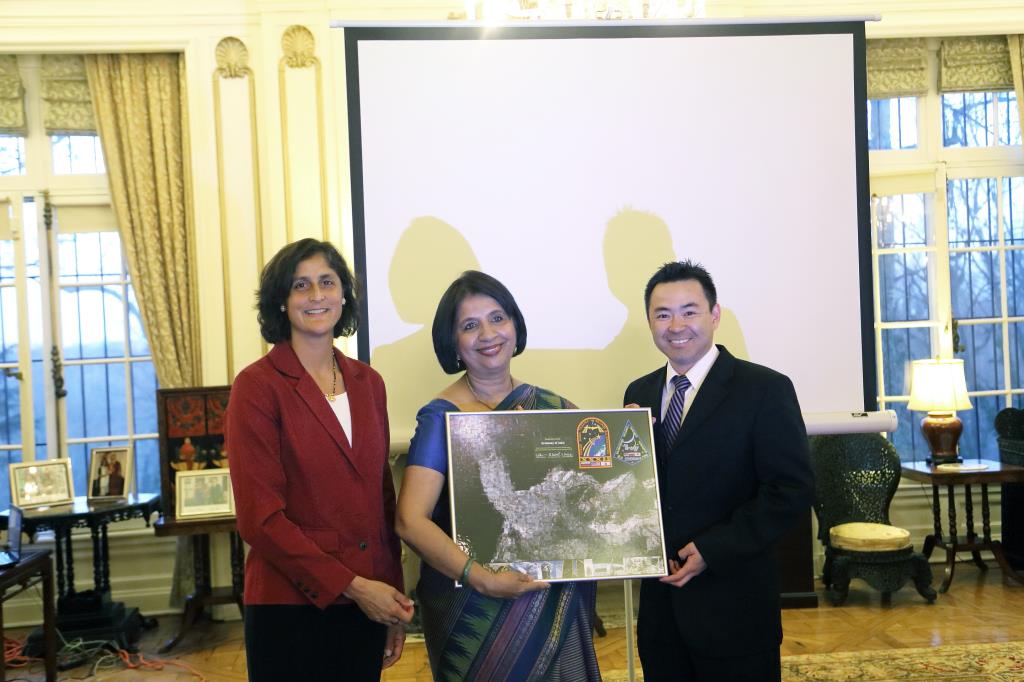
Astronauts Sunita Williams (left) and Akihiko Hoshide (right) presenting a photo of their Space Expedition to Indian Ambassador Mrs. Nirupama Rao, at a reception in the Embassy Residence. Photo credit: Embassy of India, Washington
There was no dearth of: insight and information on space, science and technology; revelation – Ambassador Rao pointed out that Williams took the Bhagavad Gita and samosas on her space expedition; and sentiment – Williams was overcome by emotion recalling her rapport with colleagues at NASA, particularly Kalpana Chawla, the first Indian-American astronaut and first Indian woman in space, who was one of seven crew members killed in the Space Shuttle Columbia disaster.
In her welcome remarks, Ambassador Rao stressed that space cooperation “is very much a part of the strategic partnership” between India, the world’s largest modern democracy, and the US, the oldest modern democracy. “We have numerous areas of cooperation between our two countries”, she emphasized. “In fact, as I always say, this cooperation touches every aspect of human endeavor. Therefore, space is so much an intrinsic part of what we do”.
Noting that it is 50 years since India’s space program began; the envoy drew attention to “an American connection”: a US sounding rocket, Nike-Apache, was launched from Thumba, at the southern tip of India, on November 21, 1963. She pointed out that over the years, significant progress has been made in the design, development and operation of India’s space system and, most importantly, in the promotion of development for India’s 1.2 billion people in the fields of education, health, telecommunications, television broadcasting, meteorology and disaster warning.
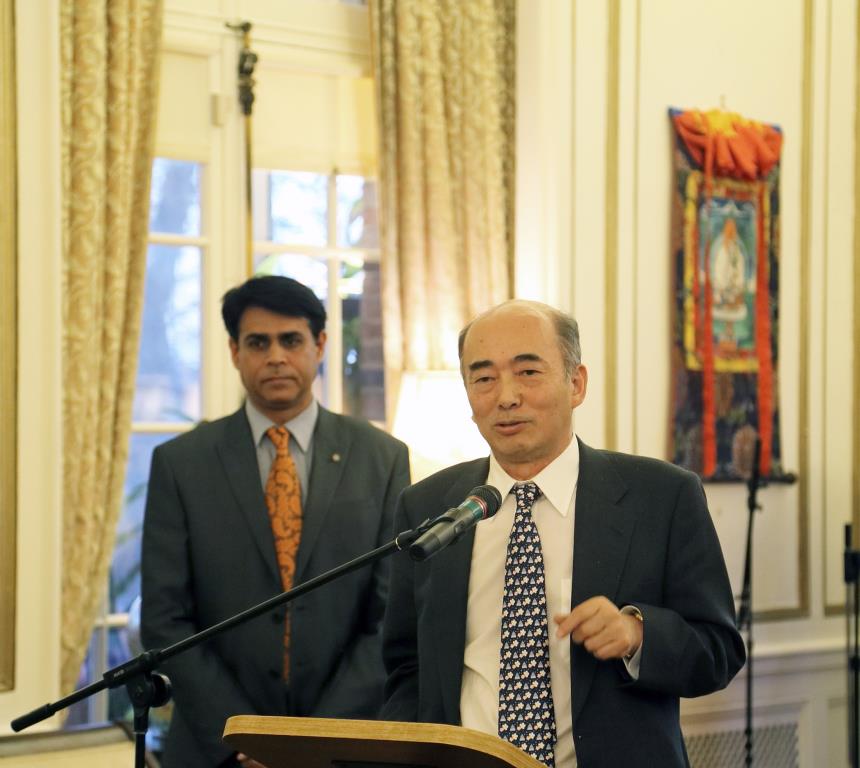
Japan’s Ambassador to the US, Kenichiro Sasae addressing a gathering at Indian Ambassador Mrs. Nirupama Rao’s Residence, Friday evening. At left is Mr. Vivek Singh, Counselor of Science and Technology at the Indian Embassy. Photo credit: Embassy of India, Washington
“With the US, our collaboration with NASA and NOAA is growing, is stronger by the year”, she said. “Today, there is a lot of data sharing that goes on in the field of remote sensing, weather forecasting and space exploration. So, there is an aspirational aspect to all of this, to the dreams and visions of 1.2 billion people in India who want to improve their lives and uplift themselves in many ways. Similarly, there is an aspirational aspect to the partnership between India and the United States. We stress the culture of innovation; we stress the culture of ideas and technology”.
To Williams and Hoshide, she said: “In all that, you signify, both of you, in what you have achieved and you’ve gone beyond the mere mundane. When we think of taking a walk, we think of taking a walk in a park or down the street and you take a walk in space. That sets you apart. You are a role model for the young people here … You make us extremely thrilled and proud for what you have achieved and what you symbolize – the desire of humanity to explore new frontiers, to literally boldly go where no man or woman has gone before which you have done”.
Recalling the visit of Williams and Hoshide to the Japanese Embassy a few days ago, Ambassador Sasae told the gathering that he queried them about the challenges they face as astronauts, to which they replied, you have to be very careful, do a lot of work, help each other.
“I saw here that there is a very wonderful combination with our Indian-Americans”, said the Japanese Ambassador. “We respect enormously the talent of Indian people about mathematics and science”.
INDIA THIS WEEK, asked Sunita Williams about her inspiration and what motivated her to become an astronaut. “Both my parents inspired me for sure since I was a child – my father in the sciences, my mother in the ‘Can Do’ attitude”, she replied. “They always told me to reach for the stars, do whatever you want to do, we are supporting you 110 percent”. Her father, Deepak Pandya, is an Indian who hails from Gujarat while her mother, Bonnie Pandya, is from Slovenia.
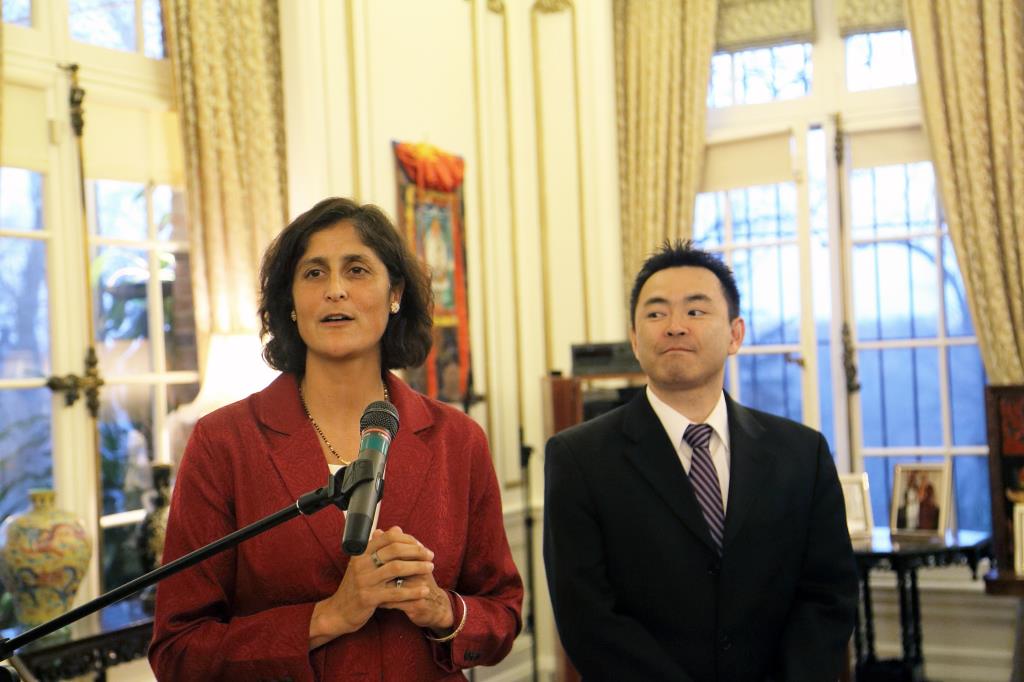
Astronaut Sunita Williams addressing a gathering at Indian Ambassador Mrs. Nirupama Rao’s Residence, Friday evening. At right is Akihiko Hoshide, an astronaut of Japanese descent. Photo credit: Embassy of India, Washington
Williams also credited her school teachers and friends she met while serving in the Navy for teaching and encouraging her about teamwork, leadership and spurring her to scale new heights. Since her father is Indian, she told us that she learnt a lot about Mahatma Gandhi and Mother Teresa who she called “a role model for compassion and heartfelt, genuine feelings for other people”.
Williams disclosed that she became “great friends” with Kalpana Chawla as soon as she joined NASA. “I miss her”, she said. “I learnt a lot from her. She taught me a whole lot about life and how to treat people and think of people living in a world without borders and how we are just citizens of the universe”.
When did you discover that you wanted to be an astronaut?, we asked. “Not until later in my life”, Williams replied. “I was in my mid twenties. I just knew I had no limits in whatever I could do”.
A highlight of the event at the Embassy Residence was an interesting and informative video, with an eloquent narrative by Williams, on her and the crew’s experiences in space – right from training and launch to science experiments in space, launching satellites, spacewalking and their vehicles.
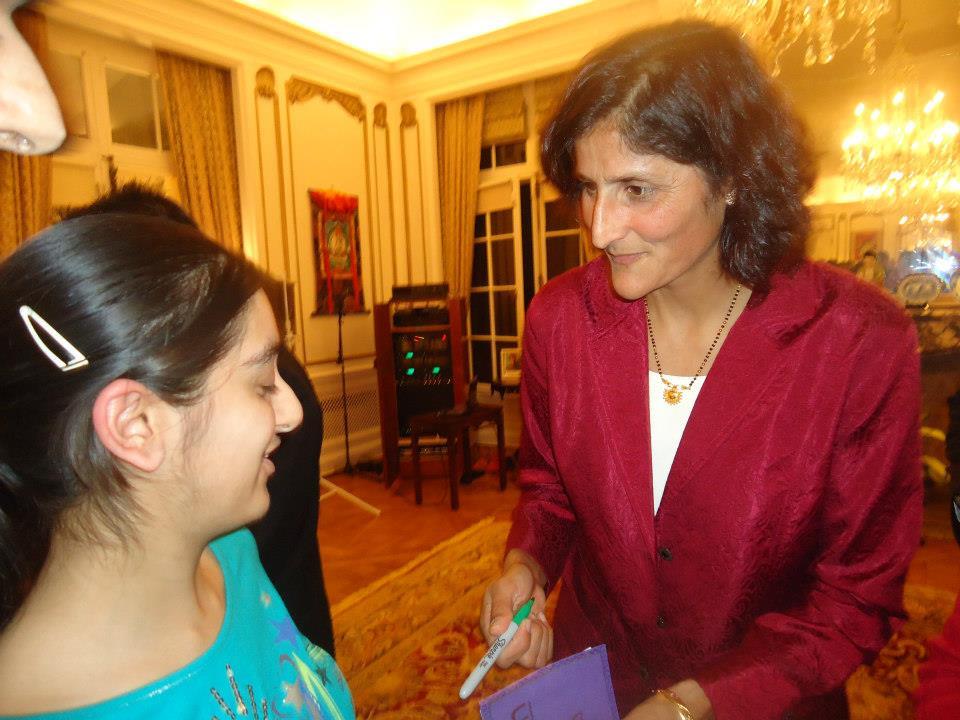
Indian-American Astronaut Sunita Williams (right) interacting with a school student at the Embassy Residence in Washington. She holds records for the longest space flight, number of spacewalks and most spacewalk time by a woman
“Four months flew by just like these five minutes (of the video presentation)”, Williams told the gathering. “It was an incredible experience. But, it wouldn’t have happened without the help and support of so many people on the ground. We are just six and there are thousands of people in all of the agencies, different countries, universities throughout the world who have sent science experiments and have supported us, our space programs, over the years to keep humans in space continually. It’s in our heart; it’s in our soul; it’s our destination to be astronauts”, she said.
Williams challenged youngsters in the audience to break their records. “We are lucky to have the opportunities that we had and we got to break records”, she told them. “But, we want people to break our records. That’s when we know that progress is being continually made”.
In an interesting account, Hoshide recalled the days of rehabilitation once they were back on earth. The astronauts would go to the gym every day where there was “a physical instructor waiting for us to torture us”, he quipped. “We were lucky that we had good exercise equipment on board … Our muscles were not very weak. We were able to stand up and walk upon landing, (albeit) like a zombie”, he said, to laughter. It took some 45 days for them to recover fully.
Throughout the evening, Williams emphasized that “the greatest part of the international space station program is, us working together as one common humanity – one world, without borders”.
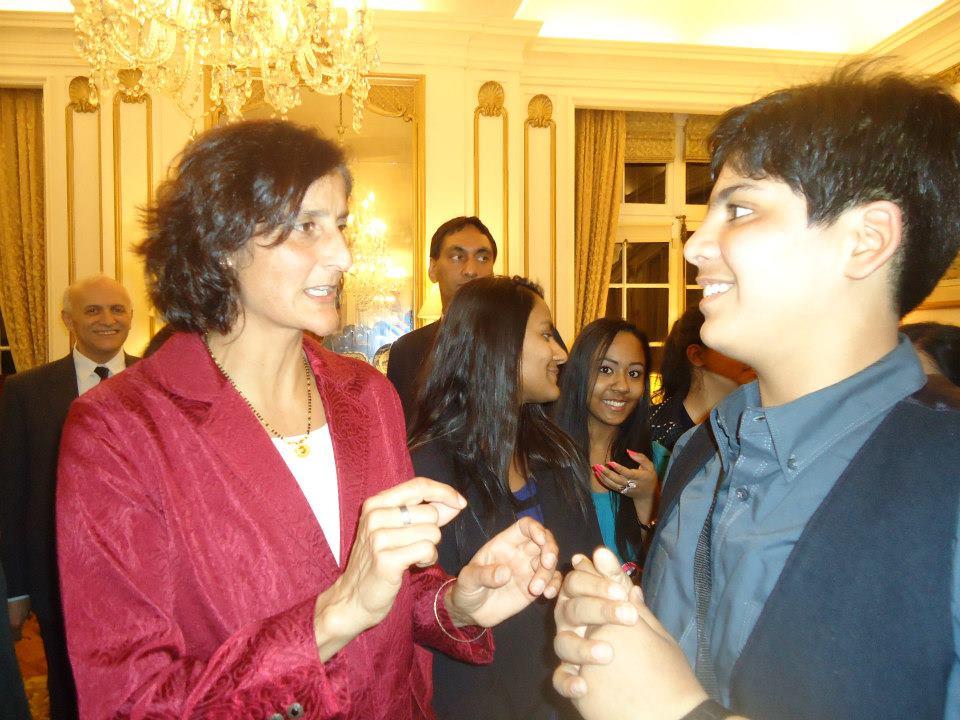
Indian-American Astronaut Sunita Williams (left) mingling with school students at the Embassy Residence in Washington. She holds records for the longest space flight, number of spacewalks and most spacewalk time by a woman
She is keenly aware of the fragility of life, and deeply appreciative. “I really feel we are so lucky to be living on this planet”, she told the audience. “I love India. I was amazed to see India from space in its full glory. This planet is amazing. We take our life here on earth for granted quite a bit”.
Ambassador Rao evoked the Sanskrit phrase, ‘Vasudev Kutumbakam’, to convey that the whole world is one single family. She quoted the American poet Archibald Macleish, looking at a picture of planet earth from space: “Behold, the blue planet steeped in it’s dream”.
Ever gracious, she told the gathering, “This is a very special occasion for us. It is not every day that we get to receive astronauts”. And it is not every day that young people are invited to such an event. About the students, Ambassador Rao said, they “are extremely thrilled to be here and to witness what I am sure is a very historic moment for them as it is for us because I think events like this stay in one’s memory throughout one’s life and I am sure they will recount this experience to their children and grandchildren as the years go by”.
All in all, it was a remarkable, a memorable event! Williams now heads to India for a visit – to Delhi, Mumbai, Kolkata and Gujarat.
Community Special by MYDOSTI.COM







































































































